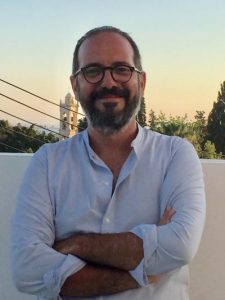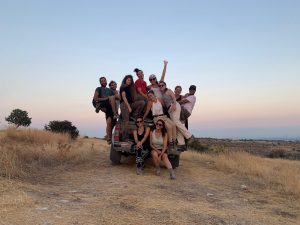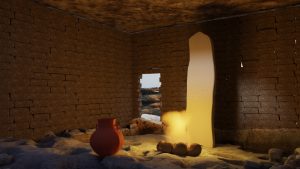Fifteen years of investigations and important new discoveries for The Italian Erimi Archaeological Project
A mysterious large monolith, with a circular motif of small cups in the centre, tells us the story from a distant era about a craftsmen community in Cyprus and led to a discovery of particular significance for defining the ideology and rituality of this ancient community.

Professor Luca Bombardieri, scientific director of The Italian Erimi Archaeological Project/Missione Archeologica a Erimi, based at the University of Siena (Department of Philology and literary criticism), in collaboration with the Department of Antiquities of Cyprus, said us about the fascinating results of many years of research work conducted by his team.
“On the occasion of the fifteenth anniversary of the first systematic investigations in the area of the Bronze Age Erimi in Cyprus, – Bombardieri argues – the positive balance of the research activity carried out is mirrored by new results of a series of research seasons particularly rich in discoveries. Recent excavations have led to find the earliest attested sacred building in Cyprus, whose ritual function and ideological value appears to be of particular significance”.
The Italian research programme benefits from the cooperation of numerous partner institutions (i.e. The Cyprus Institute, INFN-Labec) and has been able to count over the years on the valuable support of the Mediterranean Archaeological Trust, the Institute of Aegean Prehistory and, above all, the constant support of the Ministry of Foreign Affairs and the Italian Embassy in Nicosia.

Fieldwork and research activity of the Erimi Italian Archaeological Mission keep on involving a large team of 30 specialists and students from Italy, Cyprus and Greece. The core team of the University of Siena includes ungraduated and graduate students in archaeology and cultural heritage studies from Department of Philology and literary criticism and Department of History and cultural heritage , along with specialists in Mediterranean Prehistory, conservation, geo- and landscape archaeology.
The primary objective of the research project is to provide new data for the study of cultural production and relations within the transition to urban society in this key island context straddling the Near East and Mediterranean.
“The early settlement of Erimi – Bombardieri explains – is located in the hinterland of Limassol and extends on a high limestone terrace overlooking the course of the river Kouris and a large portion of
the coastline of the Gulf of Kourion and the Akrotiri peninsula. During the Middle Bronze Age (c. 2000-1600 B.C.) a community of craftsmen chose to settle on the Erimi hill and build a communal living space with very special characteristics”.
Since 2008, the systematic archaeological investigation at Erimi identified a central workshop complex located on the top of the hill.

“The rational organisation of the open spaces (large courtyards exposed to the circulation of the wind) – Bombardieri underlines – and their relationship with the enclosed spaces (small units secured by locking systems), the associated materials (millstones, spindle whorls, loom weights, pouring containers and large storage vessels) and the archaeometric investigations indicate that this workshop was intended for the production of textiles. A common space in which all the steps associated with this production could be organised: from the processing of plant and animal raw materials, to spinning, weaving and dyeing fibres and textiles. On the lower terrace of the hill, there were contemporary dwellings that were to house the community, in family living and gathering spaces”.
Recently the new discover: in the western wing of the workshop complex, a room was found from which a monolith of considerable size, approximately 2.30 m high, completely smoothed and with a circular motif of small cups in the centre.

“The monolith, which originally stood in the centre of the room – Bombardieri explains – collapsed on the floor and destroyed a large amphora placed at its feet in front of a small circular hearth. The interior space of this room was thus free for circulation around the monolith, the amphora and the hearth that occupied its central part. The peculiarities of this space, especially when compared to the surrounding spaces of the production workshop, indicate that it is a small shrine, the earliest actually attested in this island, with interesting cultic function precisely because it is located within the workshop complex. In this way, the activity that supported the community economically, also involved its members ideologically and symbolically”.
Furthermore, the new cycle of field research inaugurated in 2016 led to the discovery of an imposing circuit wall that must have stood 2m high.
“Its construction – Bombardieri adds – indicates the community’s need to defend itself from the outside but, at the same time, expresses its cohesion and desire to emphasise its collective space. Two extra moenia funerary clusters extend outside the circuit wall, characterised by funerary pits, single-chamber and multiple-chamber tombs”.

“After a long-term abandonment – Bombardieri concludes – a more sporadic frequentation during the Late Hellenistic and Roman periods is scanty attested in the area. Thus, a brand-new parallel
project started up in 2023 focused on a larger-scale analysis of the Kouris valley ancient landscape investigate the dynamics of interaction between the natural landscape and settlement strategies on a
longer-term perspective. Landscape, Identity, Network in Kouris Valley (LINK project) is a joint multidisciplinary project that involves archaeological and geomorphological survey of the valley area and benefits of the collaboration between different expertise. Three teams are coordinated on field: Archaeological Systematic excavation (University of Siena); Archaeological Survey and Topography (University of Salento, Catholic University Milano); Geomorphological Survey (University of Genova)”.

